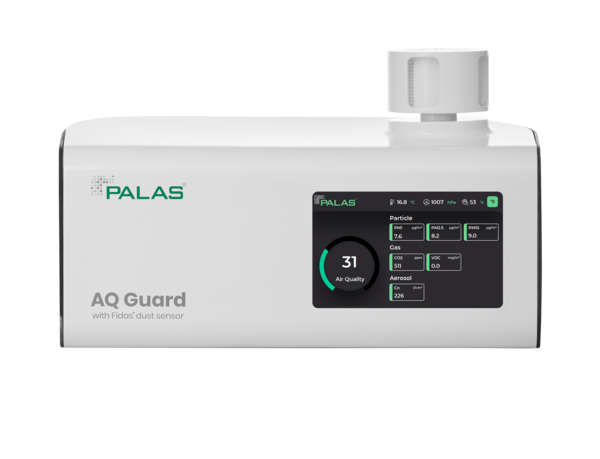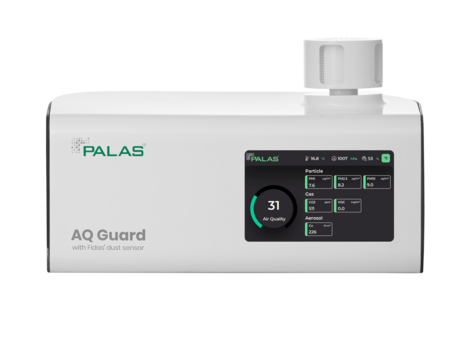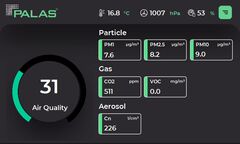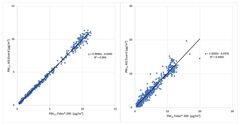AQ Guard

AQ Guard, currently the most advanced compact analyzer for determining indoor air quality, continuously and reliably analyses airborne fine dust particles in the range 0.175 – 20 µm (*1 IAHP-Package starting from 0.15 µm). A newly developed mass conversion algorithm calculates PM values based on single particle optical light scattering, considering signal duration and shape.
AQ Guard simultaneously calculates and stores PM1, PM2.5, PM4, and PM10, the total dust load, the particle number concentration CN, and the particle size distribution. Thus, AQ Guard provides comprehensive, accurate information on indoor particulate matter. This is only possible in this form with a counting single particle measurement method.
Norms and certificates
National and international standards
ISO 21501-1
Operation principle
Indoor air quality
The system works on the single particle's 90-degree scattered light measurement principle, considering signal duration and shape. Technology and algorithms were developed based on the EN 16450-certified Fidas® 200. With additional sensors for CO2, AQ Guard determines the data required to determine the air quality index (AQI).
The combined measurement of CO2 content and particle size distribution also allows conclusions to be drawn about air contamination by human germs and particles. In indoor areas, it is thus possible to determine what proportion of the air has been exhaled and therefore contains potentially infectious particles. This type of measurement data evaluation represents a new dimension in indoor air quality assessment and is available in AQ Guard as an "infection risk index" (patent pending).
Fig. 1: AQ Guard screen view
Improved efficiency allows more accurate measurement of minute particle concentration and concentration trend over time.
AQ Guard has fast data interfaces, allowing real-time Ethernet (PoE), Wi-Fi, or cellular access. All measured values are calculated and made available directly on the device. The user thus retains complete control over his data and decides which information is accessible to third parties or should be transmitted. AQ Guard continues to provide data in various formats (such as a text file) for later evaluation.
Comparison measurements
Fig. 2: Comparison of data recorded by AQ Guard and Fidas® 200 S
The high correlation values of the AQ Guard to the reference Fidas® 200 confirm the comparability of both systems.
Extensions/Accessories
AQ Guard has fast data interfaces, allowing real-time Ethernet, Wi-Fi, or mobile radio access. All measured values are calculated and made available directly on the device. The user thus retains complete control over his data and decides which information is accessible to third parties or should be transmitted. AQ Guard provides data in various formats (such as a text file) for later evaluation.
The compact design and the option of power supply via the Ethernet interface (PoE) simplify installation in buildings and integration into existing infrastructure.
AQ Guard is available in two expansion stages:
Basic version
The basic version of AQ Guard provides measured values of the fine dust fraction PM2.5 plus other variables such as temperature, air pressure, and relative humidity.
The extension "Indoor Air Hygiene Professional (IAHP)"
Compared to the basic version, the measurement limit for small particles has been extended downwards to 0.15 µm to meet the unique requirements for detecting airborne viruses.
The "Indoor Air Hygiene Professional" package is designed to meet the requirements of experts in indoor air and air hygiene and, among other things, determines values of the fine dust fractions PM1, PM4, and PM10, including particle size distribution and number concentration of particles.
AQ Control - Software for assessing the air hygiene quality of rooms
The AQ Control software can assess the dispersion and reduction of aerosols in rooms. Up to six AQ Guard systems and an aerosol generator PAG 1000 measure the accumulation, reduction of particle concentrations, and PM values over an adjustable period and objectively assess actions taken to reduce aerosol and, thus also, potential virus contamination.
(Software AQControl is part of the "Indoor Air Hygiene Professional (IAHP)" package)
Bibliography
Publications
- Jain, A.; Duill, F.; Schulz, F.: Numerical Study on the Impact of Large Air Purifiers, Physical Distancing, and Mask Wearing in Classrooms; atmosphere 14 read more
Benefits
Your special advantages
- Technology based on the type approved Fidas® 200 series (EN16450 and MCERTS); simultaneous measurement of CN, PM1, PM2.5, PM4, PM10
- With the "Indoor Air Hygiene Professional" extension: increased counting efficiency for nano-scaled particles from 0.15 µm
- Computation of air quality index based on measurements of particulates, CO2
- Estimation of infection risk based on measurements of CO2 and particulate matter
- High accuracy due to advanced algorithms
- Long term stable due to self-calibration for measurement of flow rate, particulates, and gaseous pollutants
- Operates on AC, DC, or power-over-Ethernet
Applications
Individual solutions for various industries
- Industry: production processes, bulk material handling (mixing, discharge, storage, packaging, etc.), fenceline monitoring
- Construction sites: roads, railroads, demolition sites
- Buildings: schools, kindergartens, hospitals, hotels, offices, public service buildings,
- Residential buildings near construction sites or other polluted areas
- Public transportation: airports, train stations, tramway & underground stations, cruise ships, passenger cabins, e.g., in trams, train
Technical features
In detail
- Measuring principle
- Optical light scattering at single particles
- Reported data
- PM1, PM2.5, PM4, PM10, TSP, CN, particle size distribution, ambient pressure, ambient temperature, rel. ambient humidity, CO2, Infection Risk Index, Air Quality Index (depending on configuration)
- Measurement range (number C_N)
- 0 – 20,000 particles/cm³
- Measurement range (size)
- 0.178–20 µm (with IAHP extension from 0.150 µm)
- Measurement range (mass)
- 0 – 20,000 µg/m³
- Measurement uncertainty
- R2 > 0.98 for PM2.5and R2> 0.94 for PM10versus EN 16450-certified Fidas®200 (15 min average, each)
- Volume flow
- 1 l/min ≙ 0.06 m³/h
- Size channels
- 64 (32/decade)
- Interfaces
- USB, Ethernet (LAN), Wi-Fi, 4G (optional via LTE stick)
- User interface
- Touchscreen, 800 • 480 pixel, 5" (12.7 cm)
- Protocols
- UDP, ASCII
- Data logger storage
- 10 GB
- Software
- PDAnalyze
- Data acquisition
- Digital, 22 MHz processor, 256 raw data channels
- Light source
- Long term stable LED
- Operating system
- Windows 10 IoT Enterprise
- Power consumption
- < 20 W
- Installation conditions
- -20 – +50 °C
- Response time
- 1 s, moving average configurable
- Aerosol conditioning
- Optional: thermal with compact IADS
- Dimensions
- 175 • 280 • 140 mm (H • W • D)
- Weight
- 2.4 kg
- Linearity
- 0.95 – 1.05 (measured against EN 16450 certified Fidas® 200)



